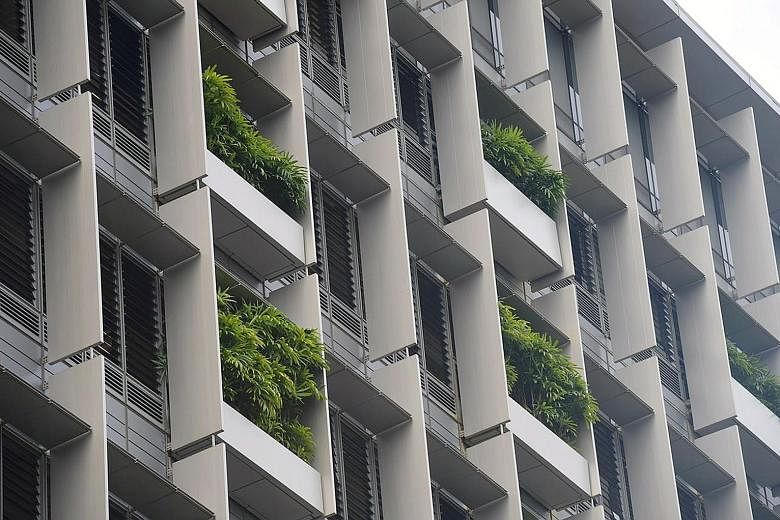Green buildings are not just a boon to the environment, they keep people healthier too. Those who work in such buildings are less likely to suffer from fatigue and skin irritation, or the other ills of "sick building syndrome", according to a new Building and Construction Authority (BCA) study which shows that the benefits of such buildings stretch beyond energy-saving.
Compared to regular buildings, green buildings are better equipped to filter out more pollutants as well as harmful bacteria and fungi. The result - workers are 60 per cent less likely to get headaches, for instance.
Khoo Teck Puat Hospital (KTPH), a Green Mark Platinum building - the highest rating for buildings in Singapore - has a cafe where the air-conditioning is turned on only when the temperature hits 34 deg C.
"Initially, staff were not used to a non-air-conditioned place because of the hot weather. But of late, our staff told us that because they are mostly in air-conditioned areas, they actually look forward to having their meals in a natural setting," said Ms Yen Tan, KTPH's chief operating officer.
The findings, released yesterday at the opening of Green Building Week, will help BCA in its efforts to make more buildings here not just environmentally friendly but also health friendly.
Scheme being developed to encourage healthy lifestyles at workplaces
BCA has tied up with the Health Promotion Board to develop a new Green Mark scheme to encourage healthy lifestyles at workplaces, with features such as indoor greenery, exercise facilities and access to healthier food and drink options. The scheme will be rolled out next year.
Said BCA chief executive Hugh Lim: "As we bring it forward, we would like to place more balanced emphasis on not only energy savings but also the well-being and health of occupants, and associated with that is the quality of air they enjoy inside Green Mark buildings."
-
S'pore not singing the blues as it aims to go green...
SCHOOLS
The BCA-Ministry of Education (MOE) Back to School Programme, which began last September, has given 26 schools the Green Mark certification, and is certifying 13 more.
In this programme, students from seven institutes of higher learning work with mentors from firms in the built environment industry to go back to their primary or secondary schools to help them attain the Green Mark certification.
There are more than 300 MOE mainstream schools which the programme aims to certify with the Green Mark.
CAPABILITY-BUILDING
BCA wants Singapore to have 25,000 local green professionals by 2025.
The country currently has around 16,000 of these professionals, who are defined as architects, engineers, project managers and facility managers trained at the BCA Academy and other institutes of higher learning.
This, however, will be a challenge due to factors such as the younger portion of Singapore's workforce being highly mobile, according to a BCA spokesman.
ENERGY USE INTENSITY TRENDS
The energy performance of commercial buildings has improved by 9 per cent from 2008 to 2016. This was measured using energy use intensity (EUI), which is the energy a building uses in one year divided by its total gross floor area.
Highlights include the hotel industry, which showed an improvement of 21 per cent. The EUI of healthcare facilities bucked the trend, increasing by 10 per cent in the same period. But this is due to Singapore's ageing population needing the use of more medical equipment.
Green Mark commercial buildings performed better than non-Green Mark buildings.
Associate Professor Tham Kwok Wai from the National University of Singapore's Department of Building, who conducted the study with BCA, said it provided "hard evidence" the Green Mark certification for buildings has worked, and that their occupants were healthier and more productive. Buildings with the Green Mark have environmentally sustainable designs such as carbon dioxide level sensors.
The study was conducted over 31/2 years on eight Green Mark-certified office buildings -and six office buildings which had no certification. It found disparities in the buildings' indoor levels of PM2.5 - microscopic particles harmful to human health. The green buildings were better able to keep PM2.5 particles and other fine particulates such as bacteria and fungi out, thanks to better filters.
Surveys conducted among about 360 occupants of both types of buildings found those working in Green Mark-certified buildings were more satisfied with their office's temperature, humidity, lighting, air quality and indoor environment.
The findings will be used to tweak the existing criteria for BCA's Green Mark schemes, which cover various properties, from shopping malls to schools.
For a start, it will pilot a new set of criteria for existing non-residential buildings for one year. This will place greater emphasis on the use of smart technologies, for instance, requiring buildings to have smart systems to monitor air quality. Currently, only about one in three buildings in Singapore is Green Mark-certified. BCA aims to increase that to 80 per cent by 2030. It hopes that sharing data on the benefits would spur more building owners, especially those with older buildings, to invest in green upgrades.
This week BCA will, for the first time, release the energy usage of three-quarters or about 1,000 of Singapore's commercial buildings along with their identities, as part of a voluntary scheme. The buildings account for 65 per cent of total building energy consumption. BCA said it is considering making the disclosure of identities mandatory.

